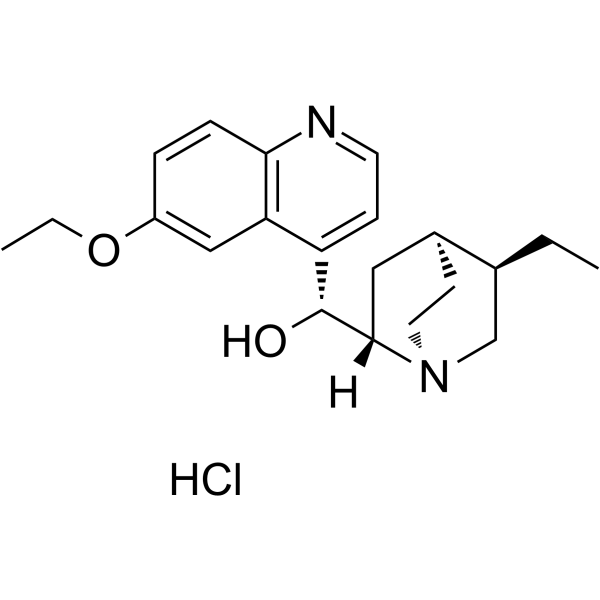Ethylhydrocupreine hydrochloride |
| Catalog No.GC63580 |
Ethylhydrocupreine hydrochloride (Optochin hydrochloride) is a quinine derivate with antimicrobial activity against S.
Products are for research use only. Not for human use. We do not sell to patients.

Cas No.: 3413-58-9
Sample solution is provided at 25 µL, 10mM.
Ethylhydrocupreine hydrochloride (Optochin hydrochloride) is a quinine derivate with antimicrobial activity against S. pneumoniae. Ethylhydrocupreine hydrochloride also possesses antimalarial activity against Plasmodium falciparum, with an IC50 of 25.75 nM. Ethylhydrocupreine hydrochloride is a Gallus gallus taste 2 receptors (ggTas2r1, ggTas2r2 and ggTas2r7) agonist[1][2][3][4].
The mutation rate to Ethylhydrocupreine (Optochin) resistance is estimated using fluctuation analysis in three capsulated S. pneumoniae strains (S. pneumoniae D39 NCTC 7466, S. pneumoniae R6 ATCC BAA-255 and S. pneumoniae ATCC 49619). The exposure to subinhibitory concentrations of penicillin increased the mutation rate (expressed as mutation per cell division) to Ethylhydrocupreine (Optochin) resistance between 2.1- and 3.1-fold for all three strains studied[2].
The injection of 1 cc. of a 24 hour dextrose blood broth culture of virulent Type I pneumococci into the right pleural cavity of guinea pigs produces acute suppurative pleuritis on both sides associated with suppurative pericarditis. The injection of 1 cc. of 1:500 solutions of Ethylhydrocupreine hydrochloride into each pleural cavity of guinea pigs at varying intervals up to 24 hours after pleural infection has usually shown a marked curative influence. Similar results are observed with dogs[1].
[1]. J A Kolmer, et al. CHEMOTHERAPEUTIC STUDIES WITH ETHYLHYDROCUPREINE HYDROCHLORIDE IN EXPERIMENTAL PNEUMOCOCCUS PLEURITIS. J Exp Med. 1921 May 31;33(6):693-711.
[2]. Paulo R Cortes, et al. Subinhibitory Concentrations of Penicillin Increase the Mutation Rate to Optochin Resistance in Streptococcus Pneumoniae. J Antimicrob Chemother. 2008 Nov;62(5):973-7.
[3]. Nassira Mahmoudi, et al. Identification of New Antimalarial Drugs by Linear Discriminant Analysis and Topological Virtual Screening. J Antimicrob Chemother. 2006 Mar;57(3):489-97.
[4]. Antonella Di Pizio, et al. Molecular Features Underlying Selectivity in Chicken Bitter Taste Receptors. Front Mol Biosci. 2018 Jan 31;5:6.
Average Rating: 5 (Based on Reviews and 5 reference(s) in Google Scholar.)
GLPBIO products are for RESEARCH USE ONLY. Please make sure your review or question is research based.
Required fields are marked with *




















